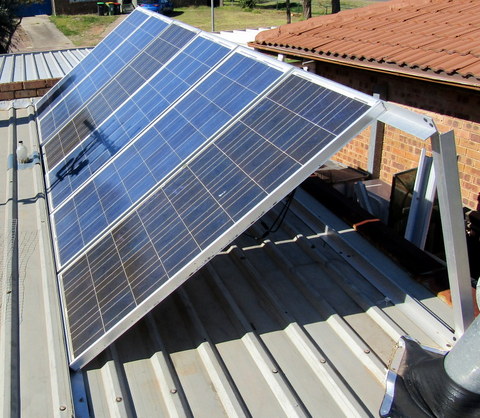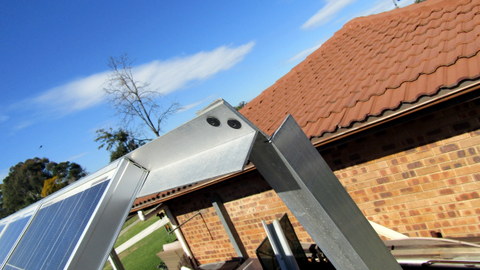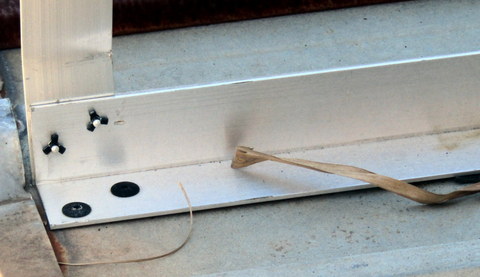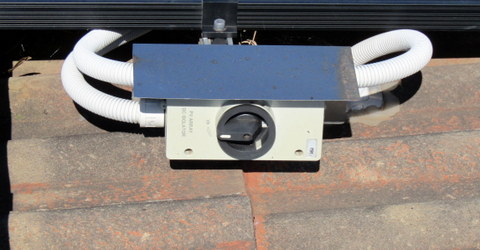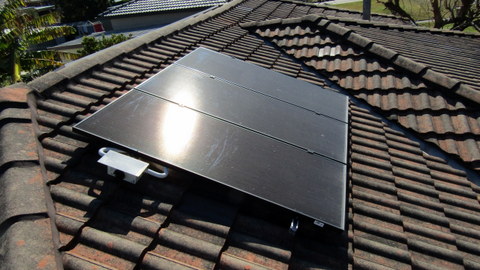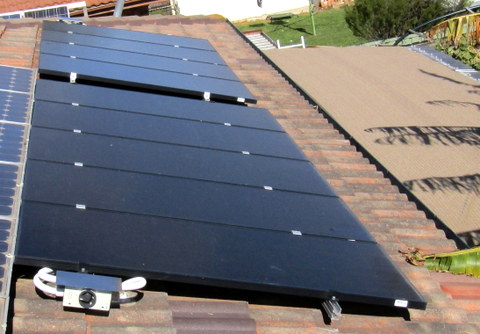We bought our first solar panel about 35 years ago, and have been adding them sporadically ever since, but they were mainly for the house lights and later on to power the fridge as well. It has only been since we started our off grid adventure that we have moved over to solar totally!
My idea was to use some of the original panels to power the remaining 12v lead acid battery bank which would still run the lights, but there were some problems that developed with that approach fairly quickly –
1. The panels I had set aside to do the work (the 4 x 83 watt solarex panels) steadfastly refused to operate when I tried to reconnect them. The top hat section aluminium I used to support them came unhooked at one point allowing the panels to warp a bit causing the glass front on one panel to shatter, which I’m sure didn’t help. There were also other problems with wires falling off and diodes coming unglued, even my ‘solar guru’ was unable to resuscitate them, so they have now been removed from the system. And….
2. The remaining 12 volt lead acid battery bank died!
So after all that I wired the lights into the 24vDc to 12vDC converter and the rest, as they say, is history.
While all this was going on I was working out how to run the new system so it would take care of everything, and that took a bit of doing! The solar panel part of the system basically developed in three distinct spurts –
Spurt 1
On the day we did most of the work on the installation I had a working bee at our place to give people an opportunity to learn how to do this. My solar guru (I dunno……. Let’s call him Mike!) ran it, I charged people to come and it covered the cost of his services for the day. (win – win!).
On that day the guys made up a support frame for the 6 solar panels I already had which were going to form the nucleus of the new system, ie 2 sharp panels (130w 22v 8.09 amps each) already in use plus the four SolarE panels (130w 17.3v 7.51 amps each) which had been sitting in the garage since I bought them some years ago. They made the support frame out of 50mm x 50mm x 2mm aluminium angle, bought specifically for the purpose, and pop riveted them together.
The southern end of the panels are supported by the framework made up of a top and bottom horizontal piece, connected by four vertical pieces to support the panels at an angle of 45° approximately. The top horizontal piece is pop riveted to the panels and bottom is pop riveted into the roof of the garage (more about that later). The bottom of the panels are supported in a single horizontal run of aluminium angle which is also pop riveted into the roof of the garage.
Now, the roof of the garage is composed of steel Hidek profile roofing, which means that it has wide flat bits, with stiffening ribs every 200mm or so. Anyway, I have always mounted panel supports on the top of the stiffening ribs to reduce the likelihood of leaks, but the guys installed the panel supports on the flat bits in between. I expressed my concerns but was told the pop rivets would be tight enough to stop leaks. Word to the wise – they’re not!
With the system installed and the panels in place it was just a case of waiting to see how much power we developed, unfortunately it was not enough! Hence….
Spurt 2
To increase the power we were getting to somewhere (hopefully) where it needed to be, I bought in four Stion brand 140watt thin film panels, they were recommended by mike as being particularly good in low light conditions and that has certainly been the case.
They were installed professionally with their own isolator on the western facing back roof of the house. We have only a small amount of north facing roof which has, for the last 35 years or so, been home to one sort or other of solar hot water system, so the new Stions were installed on the back as it was the largest continuous bit of roof we have.
This resulted in a total power output of 1200 watts, maximum, which in high summer is fine. Our house consumes about 5kWhr of electricity per day, minimum and so on the shortest day, and for a month or two either side, 1200 watts would not be enough. The output of the panels was still well within the maximum amperage the MPPT could deal with, which was 50 amps, so this lead on to –
Spurt 3
To make sure that I had enough power for the shortest day I bought and had installed professionally another 8 Stion brand thin film panels. I had them installed in two sections so that it would spread my power generation over the course of the day, rather than flood the batteries with power and exceed the ability of the MPPT to direct all the power to the batteries. So five panels went onto the western side of the roof, just north of the original four, and the remaining three we put on the front (eastern side) of the house roof to catch the early morning sun.
Theoretically the system would yield a bit less than 2.5 kW but practically the maximum we get is about 1.8kW, which is a bit more than the MPPT can deal with but anything over the 50amps it is rated for doesn’t get fed through to the batteries, it hasn’t caused a problem so far.
The result is that if the shortest day is clear, we get about 5 to 5.5 kWhrs for the day so it works!



